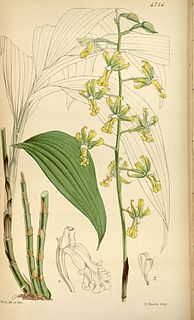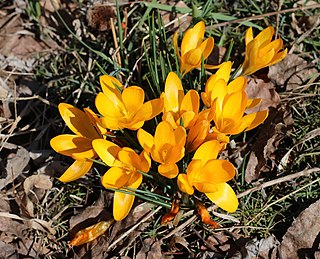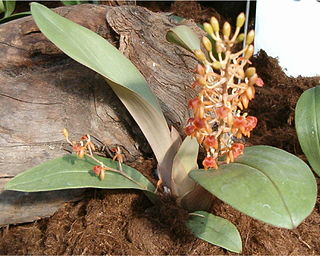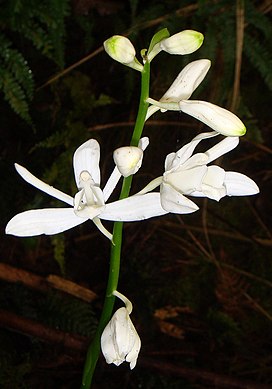
John Lindley FRS was an English botanist, gardener and orchidologist.

Acanthophippium is a genus of orchid with thirteen species. The name of this genus is derived from the Greek words acanthos ("spiny") and ephippion ("saddle"), referring to the saddle-like labellum of the plants.
In botany, an umbel is an inflorescence that consists of a number of short flower stalks which spread from a common point, somewhat like umbrella ribs. The word was coined in botanical usage in the 1590s, from Latin umbella "parasol, sunshade". The arrangement can vary from being flat-topped to almost spherical. Umbels can be simple or compound. The secondary umbels of compound umbels are known as umbellules or umbellets. A small umbel is called an umbellule. The arrangement of the inflorescence in umbels is referred to as umbellate, or occasionally subumbellate.

Cephalantheropsis is a genus of orchids, comprising 4 accepted species distributed in China, Japan, the Eastern Himalayas and Southeast Asia.

Phaius, commonly known as swamp orchids or 鶴頂蘭屬/鹤顶兰属 , is a genus of forty five species of flowering plants in the orchid family, Orchidaceae. They are evergreen, terrestrial herbs which form clumps with crowded, sometimes stem-like pseudobulbs, large, pleated leaves and relatively large, often colourful flowers. Species in this genus are found in the tropical parts of Africa, Asia, Southeast Asia, New Guinea, Australia, and various islands of the Pacific and Indian Oceans. One species is also naturalized in Hawaii, Florida, and the Caribbean.

Charles Bennet, 4th Earl of Tankerville, styled Lord Ossulston from 1753 to 1767, was a British nobleman, a collector of shells and a famous patron of Surrey cricket in the 1770s. He agreed a set of cricket rules that included the first mention of the Leg before wicket rule. His wife, Emma, Lady Tankerville, was notable as a collector of exotic plants. The first tropical orchid to flower in England is named for her as it was it flowered in her greenhouse. Her collection of over 600 illustrations were purchased by Kew Gardens in 1932 and are still available today.
The hybrid elm cultivar Ulmus × hollandica 'Cinerea' was first listed by George Lindley in 1815, as Ulmus cinerea, the Ash-coloured Elm, and later by the André Leroy Nurseries, Angers, France, in 1856. It was distributed as Ulmus cinerea by the Baudriller nursery, Angers, and as Ulmus montana cinerea by Louis van Houtte of Ghent. A specimen in cultivation at Kew in 1964 was found to be U. × hollandica, but the tree at Wakehurst Place remains listed as U. glabra 'Cinerea'.

Microstegium is a genus of African, Asian, and Pacific Island plants in the sorghum tribe within the grass family. Browntop is a common name.

Dendrobium lindleyi, also known as Dendrobium aggregatum, is a plant of the genus Dendrobium. They are found in the mountains of southern China and Southeast Asia.

Crocus flavus, known as yellow crocus or Dutch yellow crocus, is a species of flowering plant in the genus Crocus of the family Iridaceae. It grows wild on the slopes of Greece, former Yugoslavia, Bulgaria, Romania and northwestern Turkey, with fragrant bright orange-yellow flowers which Tennyson likened to a fire. It is a small crocus (5–6 cm, despite the names of some cultivars, compared to the Giant Dutch crocuses. Its cultivars are used as ornamental plants.

Gastrochilus obliquus is a species of orchid native to China, the Himalayas and Southeast Asia. Two varieties are recognized:

Liparis latifolia is a species of orchid native to Hainan, Thailand, Indonesia, Malaysia, the Philippines and New Guinea.

Otochilus is a genus of flowering plants from the orchid family, Orchidaceae. It contains 5 known species, native to China, the Himalayas and Southeast Asia.
- Otochilus albusLindl. - Tibet, Assam, Bhutan, India, Nepal, Myanmar, Thailand, Vietnam
- Otochilus fuscusLindl. - Yunnan, Assam, India, Nepal, Bhutan, Indochina
- Otochilus lancilabiusSeidenf. - Tibet, Assam, India, Nepal, Bhutan, Laos, Vietnam
- Otochilus porrectusLindl. - Yunnan, Assam, India, Nepal, Bhutan, Indochina
- Otochilus pseudoporrectusSeidenf. ex Aver. - Vietnam

Phaius tankervilleae, commonly known as the greater swamp-orchid, swamp lily, swamp orchid, nun's-hood orchid, nun's orchid, veiled orchid, Lady Tankerville's swamp orchid or 鹤顶兰 , is a species of orchid native to areas from Asia to islands in the Pacific Ocean. It has large, pleated leaves and tall flowering stems bearing up to twenty five white, brown, mauve and yellow flowers. It was named for Lady Tankerville who owned the greenhouse where the first orchid flowered. It was the first tropical orchid to flower in England.

Phaius robertsii, commonly known as forest swamp orchid, is a plant in the orchid family and is native to a small area of Tropical North Queensland and to New Caledonia. It is an evergreen, terrestrial herb with above-ground stems, three to five pleated leaves and up to twenty flowers which are yellow on the back and brick-red inside. It grows in wet places in rainforest.

Phaius philippinensis is a species of orchid in the genus Phaius that was described by N. E. Brown in 1889. It is endemic to the Philippines.

Phaius antoninae is a species of orchid in the genus Phaius that was described in 2011 and is native to the Philippines. The type specimen was collected by Antonina G. Balzer in August 1997.

Phaius fragilis is a species of orchid in the genus Phaius endemic to the Philippines.

Phaius borneensis is a species of orchid in the genus Phaius. It is native to the Islands of Borneo, Palawan and Mindoro.

Phaius amboinensis, commonly known as Arnhem Land swamp orchid, is a plant in the orchid family and is native to areas from Malesia through to New Guinea, Australia and islands in the Pacific Ocean. It is an evergreen, terrestrial herb with up to eight pleated leaves and up to twenty, relatively large white flowers with a yellow labellum. It grows in wet, shady forests.


















